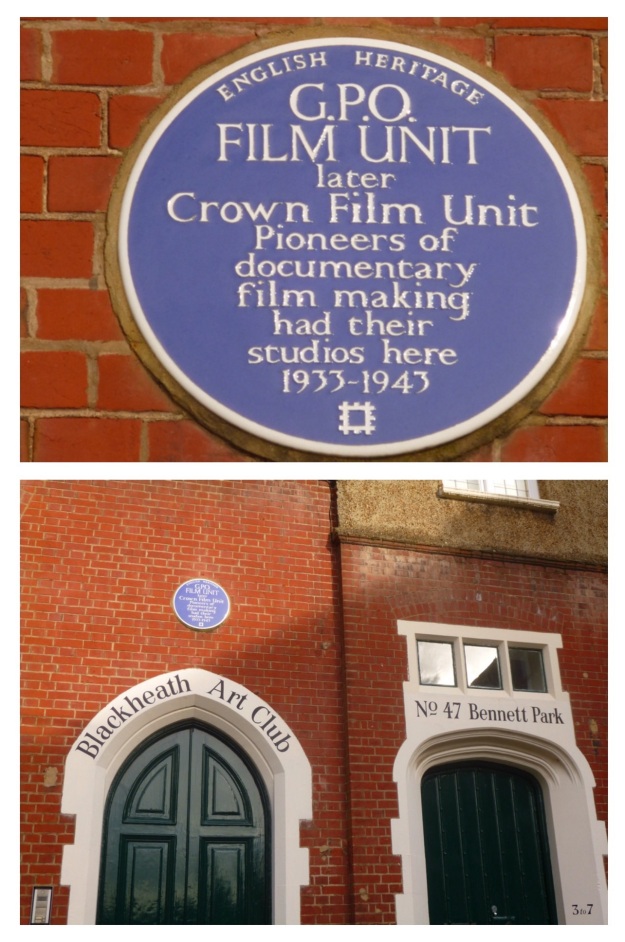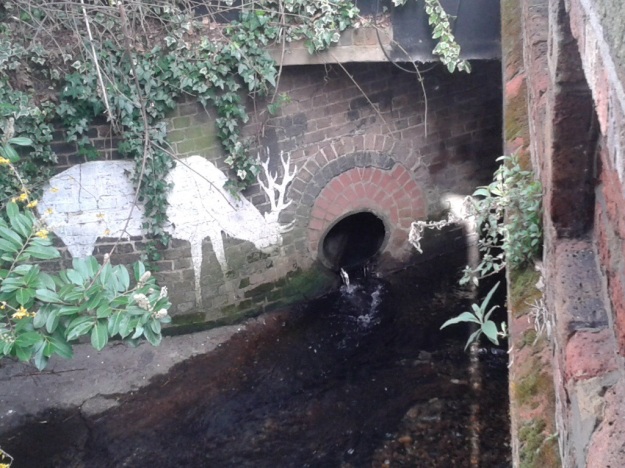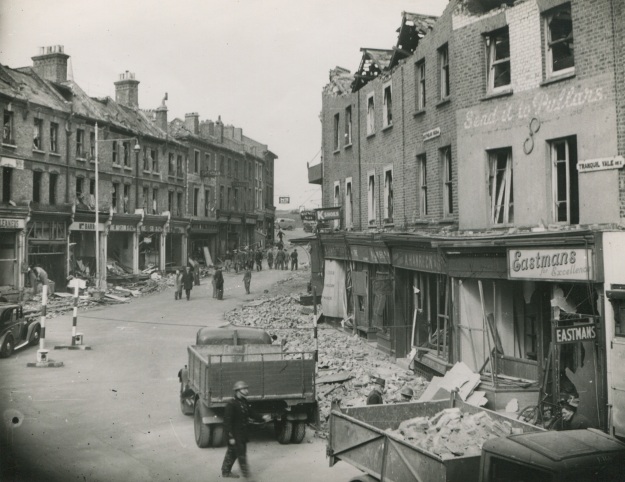A while ago Running Past looked at Northbrook Cricket club who had a ground In an area bounded by Manor Lane, the railway from Hither Green, Burnt Ash Hill and Holme Lacey Road. They had cricketing next door neighbours – Granville, whose ground had some illustrious visitors and parts of whose story we will look at now.

Unlike Northbrook, the club wasn’t formed in Lee, it had been in existence in Blackheath for 18 years before it arrived in Lee in 1884, a decade after its neighbours. Like Northbrook, it was a name that related to local landowners. The name Granville appears in several street names including on the northeastern side of Lewisham High Street, Granville Park and the lost Granville Mews – the ‘ghost’ of its name superimposed over the lovely Holdaway ghost sign on Belmont Hill.

Long and Lazy Lewisham blog noted the derivation earlier in the year – it was a family middle name used by the Eliot family who were the Earls of St Germans. It would have been the 3rd Earl of St Germans, Edward Granville Eliot, who the parish would have been referring to when naming the streets.
The club appears to have been set up by Pearse Morrison (1) a commercial stationer and printer, who lived in Blackheath at a house on one of those streets named after the Earls of St Germans – 5 Eliot Park (2).
They played on the Heath (3), the freeholders for which were the Legge family, later the Earls of Dartmouth; there were 18 adult cricket pitches on the Heath in 1890 and no doubt a similar number a few years before (4). However, there was no booking system for pitches with a “first there has the ground” rule (5), so for a club with seemingly wealthy members it may have encouraged them to look elsewhere.
The moved to Lee was for the 1884 season, that campaign was good one – they played 23 won 11, lost 2, drew 10 (6).
A prominent name in the club around the time of the move to Lee was ‘Furze’ who lived at The Laurels, also known as Laurel Cottage, a large house on Hither Green Lane from the mid to late 1860s until the early 1880s. It was initially home to wine merchant Thomas Holloway Furze who died in 1869, and his wife Emma who died in 1882. At least three of their sons played for the club (7).
Frederic, born in 1852, who was the club Vice President in 1878 (8). He moved to Copers Cope Road in Beckenham by 1881, along with his brother Edwin, it seems that they took over his father’s wine business.
Herbert Furze (1856), unlike his brothers, became a stationer and after living at The Laurels in 1881, he had married and moved to Foots Cray by 1891.
Edwin (1858) was also living at the The Laurels in 1881, but moved closer to the ground and in 1891 was at 56 Handen Road. Edwin was still playing at that point and in pictured in the 1893 team photo, which we’ll cover later.
During the 1890s a well known name played in several matches against Granville – Sir Arthur Conan Doyle who played for Norwood. Conan Doyle was a decent cricketer and played several First Class matches for the MCC, just down the road from 221B Baker Street. His cricketing claim to fame was getting perhaps the biggest wicket of all, W G Grace.
The game’s afoot …..Conan Doyle’s first match in Lee was in 1891, when C J M Godfrey ripped through the Norwood batting taking five wickets, more on Godfrey later. Doyle fell cheaply, stumped off W Edwards bowling, taking no wickets himself. Like all the other batsmen he struggled on a rain sodden pitch in Norwood in a drawn game in September 1892. In July 1894 a Conan Doyle 38 saved the Norwood from defeat in Second XI match in Lee.
Later the same season, he opened the batting for the 1st XI in a fixture at Norwood’s Pavillon Grounds, getting 20 before Helder bowled him, one of 8 wickets taken by him. Whilst Doyle picked up a wicket it wasn’t enough to prevent a heavy defeat to Granville.
A Granville team photograph survives for the 1893 season. Many of the names are ‘lost’ in terms of who they were but a few are worth mentioning. Charles John Melville (C J M) Godfrey was a professional who the club employed. He was a right-handed batsman and a right-arm fast bowler who played a handful of first class matches for Sussex between 1885 and 1892 with a career best bowling of 5 for 22 in 1890, and a best of 17 with the bat in his final match against Yorkshire in 1892. Whilst playing for Oxford University his bowling was described as ‘energetic, if erratic’.

Perch (bottom row) was the grounds man (9) – it isn’t clear whether the lack of initial related to this status. Edwin Furze (next to bottom row) we’ve already covered above. George Helder, who we’d seen above taking the wicket of Sir Arthur Conan Doyle, was the son of the Vicar of St Mildred’s church, a few hundred metres from the ground – he was 17 in 1893.
Philip P Lincoln lived at a house almost opposite St Mildred’s church and was a Lime and Cement merchant. He seems to have continued his involvement in the club until the outbreak of World War 1. Hope was expressed that he would be able to keep the club going after the loss of the ground (10).
R A (Richard Alfred) Glover, the bearded man in the centre of the picture, was the owner of the Wenlock Brewery in Hoxton, who lived at 143 Burnt Ash Road. He was presumably an officer of the club and will have made sure that the bar was well supplied. He’d moved onto Croydon by the time of his death in 1898.
During the 1893 season their primary matches were against Bickley Park, Croydon, Crystal Palace, Hampstead, Tunbridge Wells, Charlton Park, Streatham, Forest Hill, Hornsey, Blackheath, Bradfield Waifs, and a benefit against MCC and Ground (11) the ‘MCC’ were the amateurs who were members, the ‘Ground’ the professionals. There was no league structure and the games were virtually all friendlies.
1893 saw the tradition of an August tour of Sussex continue with a week of matches in Eastbourne, St Leonards and Willingdon (12).
There was also a home Granville Cricket Week in early August – the 1893 edition included games against Old Chigwellians, Border Regiment, Stoics, Eltham and a defeat to Forest Hill (13).
Fast forward into the new century a name appeared in the Granville scorecards that will be familiar to most people – W G Grace. Running Past covered his later years in south London a while ago. The last club he played for was Eltham and his first match for them was against Granville on 28 May 1910, at Chapel Farm (the current site of Coldharbour Leisure Centre). His impact was limited, while he opened the batting for Eltham he was trapped leg before wicket for 3 (14). An excellent scalp for an unnamed Granville bowler – likely to be either A S Johnson or J A Rutter who seem to have opened the bowling much of that season.

As well as turning out for Eltham, Grace still played for the MCC and captained them in their regular appearance at the Granville Cricket Week in 1912. Granville were made to bat and skittled out for 63; the MCC after an early wobble comfortably surpassed the home team’s score. E L Downey took 5-36 for Granville. In the other fixtures at Lee that week, they lost a thrilling final match to Guys Hospital by 2 runs despite a good opening partnership between J O Anderson and N Cockell. Earlier in the week Anderson had put together a team which Granville had beaten. They had also lost heavily to a Hampstead team that contained Harold Baumgartner who played Test Cricket for South Africa – his slow left-arm spin on a drying pitch had bewildered the Granville batsman – taking 9 wickets very cheaply, eight of them bowled (15).
Grace appeared again in Lee for the MCC in 1913, they heavily defeated the men from Granville scoring well over 300 before dismissing the home team for less than 100, Grace’s contribution is not known. In the Granville Cricket Week that year there were three victories for the home team – against Forest Hill, Hampstead and J Anderson’s XI, with defeats Wanderers, Richmond as well as the MCC. In games against J Anderson’s XI and Hampstead (and possibly others) there was a significant name playing for Granville, Cyril ‘Snuffy’ Brown who scored a century and took 9 wickets in the first of these (16).
Brown was a West Indian Test cricketer described as ‘a devastating bowler and attacking batsman’ who was a pioneer of bowling the ‘googly.’ He had already played for Barbados and the West Indies against the MCC when he came to London to train as a barrister in 1911. He mainly played for Clapham Rovers but in an era where clubs only played friendlies he turned out for several others, including Granville. It wasn’t just his bowling that impressed – he was described as ‘a brilliant field(er), and a splendid batsman; he has an easy style and can pull a ball with remarkable ease’ (17).
He returned to the West Indies in 1914, going on to be the first black captain of an island team, and had it not been for the racism within West Indies cricket may well have gone on to captain the Test team.
An article in the Sporting Life in 1913 noted that the end was nigh for the ground, with development planned for after the 1914 season. World War One brought cricket to a halt there most sport – as we saw with Catford Southend. Cricket doesn’t seem to have restarted in Lee after the war (18).
The housing took a while to arrive – Holme Lacey Road was built by W J Scudamore in the early 1920s. The pavilion whose steps, W G Grace, and Snuffy Browne walked down is now occupied by 53 and 55 (pictured).

The Granville ‘square’ where Sir Arthur Conan Doyle will have taken guard was covered by the Chiltonian Biscuit factory which had moved on from Staplehurst Road. Today, it is the home of the Chiltonian Industrial Estate, pictured below, the square would have been at the far end of the photograph.

Notes
- 12 October 1878 – Kentish Mercury
- 20 July 1877 – Kent & Sussex Courier
- 19 June 1913 – Sporting Life Re Heath
- Neil Rhind (1987) The Heath pp 55-56
- ibid
- 26 September 1884 – Kentish Mercury
- 12 October 1878 – Kentish Mercury
- ibid
- 21 September 1893 – Cricket
- 19 June 1913 – Sporting Life
- 13 April 1893 – Cricket
- 19 April 1893 – Sporting Life
- 10 August 1893 – Sporting Life
- 02 June 1910 -Cricket
- 19 June 1912 – The Sportsman
- 19 June 1913 – Sporting Life
- 07 September 1912 – Illustrated Sporting and Dramatic News
- 19 June 1913 – Sporting Life
Picture and Other Credits
- The drawing of Sir Arthur Conan Doyle is via the Illustrated London News on 25 May 1901
- The photograph of Snuffy Brown is via the Illustrated Sporting and Dramatic News 07 September 1912
- The picture of W G Grace is from a year or two before he played for Eltham, as it is in the colours of London County, it is on a Wikimedia Creative Commons
- Census and related data comes via Find My Past, subscription required
- The 1893 team photograph & the picture of the Chiltonian Biscuit Factory are part of the collection of Lewisham Archives, they are used with their permission but remains their copyright
- The map showing the location of the ground is on a non-commercial licence via the National Library of Scotland




















































































